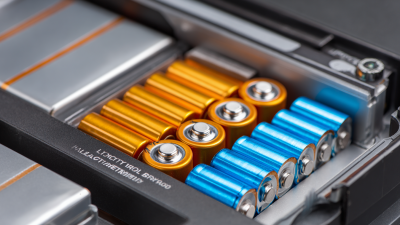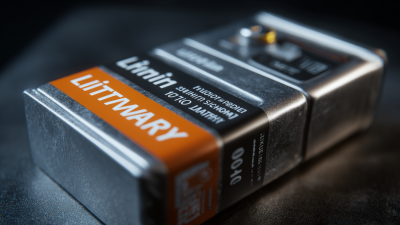Unlocking the Future of Energy with Innovative Lithium Cell Technology
As the global demand for clean and sustainable energy sources continues to rise, innovative technologies, particularly in lithium cell development, are playing a crucial role in shaping the future of energy. According to a recent report by the International Energy Agency (IEA), the lithium-ion battery market is projected to grow significantly, with an expected increase in global battery production capacity reaching approximately 3,000 GWh by 2030. This surge is fueled by advancements in lithium cell technologies, which enhance energy density, cycle life, and charging speeds, making electric vehicles and renewable energy storage more viable. Moreover, a study from BloombergNEF predicts that the battery price per kilowatt-hour will fall below $100 by the mid-2020s, further highlighting the transformative potential of lithium cells. By unlocking the advanced capabilities of lithium cell technology, we can pave the way for a sustainable future, addressing energy challenges and supporting the transition to a low-carbon economy.

Revolutionizing Energy Storage: The Role of Lithium Cell Technology
The role of lithium cell technology in revolutionizing energy storage has never been more vital as the demand for sustainable solutions intensifies. While traditional lithium-ion batteries have powered advancements in electric vehicles and renewable energy, emerging research indicates that AI is uncovering alternatives that could surpass these conventional technologies. Notably, scientists have recently identified novel porous materials that promise higher efficiency and energy density than lithium. This shift could lead to batteries that are lighter, faster to charge, and possess longer lifespans, making them ideal for widespread use.
Moreover, the evolution of battery technologies aligns with the pressing need for reliable energy storage solutions amid the global transition to renewables. As reported, grid-scale battery storage could significantly advance energy systems by harnessing solar and wind power more effectively. With advancements in anode-free battery technologies and improved material designs, the future of energy storage looks promising. The emergence of such innovations reflects an industry poised for transformation, with predictions suggesting that by 2030, advanced energy storage solutions could account for nearly 30% of the global energy storage market.
Unlocking the Future of Energy: Lithium Cell Technology
This chart depicts the growth in energy density of lithium cell technology from 2010 to 2023. The data reflects significant advancements in lithium-ion batteries, showcasing improvements in energy density (measured in Wh/kg), highlighting the potential for higher efficiency in energy storage solutions.
Key Innovations in Lithium Cell Design for Enhanced Efficiency
The energy landscape is evolving, and innovative lithium cell technology is at the forefront of this transformation. Recent advancements in lithium cell design have significantly enhanced efficiency, paving the way for more sustainable energy solutions. According to a report by the International Energy Agency (IEA), the efficiency of lithium-ion batteries has increased by over 35% in the last decade, enabling longer-lasting performance for electric vehicles and renewable energy storage systems.
Key innovations include the use of solid-state electrolytes, which have been shown to improve safety and energy density. Studies suggest that solid-state lithium cells can achieve energy densities exceeding 400 Wh/kg, compared to conventional lithium-ion cells that typically max out around 250 Wh/kg. Additionally, enhanced anode materials, such as silicon composites, are set to revolutionize energy storage by offering higher capacity and faster charging times, contributing to a more efficient overall system.
Tip: When considering new energy solutions, always look for products incorporating the latest lithium cell technology to ensure optimal performance and longevity. Also, prioritize manufacturers who demonstrate a commitment to sustainability by using eco-friendly materials in their battery designs.
Sustainability in Focus: Eco-Friendly Practices in Lithium Cell Production
The production of lithium cells is undergoing a significant transformation as sustainability takes center stage in the energy sector. According to a report by the International Energy Agency (IEA), the demand for lithium-ion batteries is projected to surge, reaching 2,000 GWh by 2030, largely driven by electric vehicles and renewable energy storage. However, this rapid expansion raises critical concerns regarding the environmental impact of lithium extraction and battery manufacturing processes. Companies are increasingly adopting eco-friendly practices to mitigate these issues, such as utilizing brine extraction methods that use less water and energy compared to traditional hard rock mining.
In the pursuit of sustainable lithium cell production, innovators are also focusing on waste reduction and recycling processes. A study by the National Renewable Energy Laboratory reveals that recycling end-of-life batteries can recover up to 95% of valuable materials, significantly decreasing the need for new raw materials while minimizing landfill waste. As the industry moves towards a circular economy, manufacturers are exploring closed-loop systems that allow for repurposing the lithium and other components from discarded cells, thus reinforcing sustainability and reducing the carbon footprint associated with lithium cell technology. These advancements not only help protect our environment but also ensure a more efficient and responsible approach to meeting the growing energy demands of the future.

Future Trends: The Impact of Lithium Cells on Renewable Energy Integration
The integration of lithium cell technology is poised to revolutionize the renewable energy landscape. As we witness a rapid shift towards sustainable energy sources, the role of lithium batteries has become increasingly crucial in enhancing energy storage capabilities. With their high energy density and efficiency, lithium cells enable seamless storage of energy generated from solar, wind, and other renewable sources, ensuring that this energy can be effectively utilized even when generation is low.
Tips: To maximize the benefits of lithium cell technology in renewable energy, consider investing in systems that use advanced battery management to optimize performance and extend lifespan. Additionally, staying informed about new advancements in lithium technology can help you make better choices for energy solutions that align with global sustainability goals.

Future trends indicate that as lithium cell technology matures, we will see a rise in hybrid systems that combine various renewable sources coupled with innovative energy storage solutions. This not only promises a more stable energy supply but also enhances grid resilience. Policymakers and investors who recognize these trends will be well-positioned to foster the growth of sustainable energy infrastructures worldwide.
Tips: Exploring community solar programs or cooperative energy storage initiatives can further enhance access to renewable energy, ensuring wider adoption and impact of lithium cell technology on future energy systems.
Challenges and Opportunities in Scaling Lithium Cell Technology for Mass Adoption
The rapid evolution of lithium cell technology presents both significant challenges and remarkable opportunities for mass adoption. As industries move towards cleaner energy solutions, scaling up production and streamlining supply chains are crucial to meet the soaring demand for electric vehicles and renewable energy storage. One major challenge is the sourcing of raw materials, particularly lithium, cobalt, and nickel, where geopolitical issues and environmental concerns can interrupt supply. Ensuring sustainable mining practices and developing alternative materials are vital steps to address these challenges.
Moreover, the complexity of manufacturing advanced lithium cells adds another layer of difficulty. Achieving economies of scale while maintaining high safety and performance standards requires substantial investment in research and development. Innovators must also tackle the aging and inefficiency of existing technologies to create more durable and efficient cells. However, these hurdles are coupled with opportunities for innovation. Businesses that invest in new technologies, such as solid-state batteries or enhanced recycling processes, can become leaders in a rapidly evolving market, ultimately kickstarting a revolution in energy storage solutions.
Unlocking the Future of Energy with Innovative Lithium Cell Technology - Challenges and Opportunities in Scaling Lithium Cell Technology for Mass Adoption
| Dimension | Value |
|---|---|
| Initial Cost per Cell | $100 |
| Energy Density | 250 Wh/kg |
| Lifecycle (Charge Cycles) | 2000 |
| Environmental Impact Score | 4.5/10 |
| Global Market Growth Rate | 18% (CAGR) |
| Recycling Rate | 30% |
| Government Incentives | Yes |
| Key Challenges in Scaling | Supply Chain, Resource Availability |
Related Posts
-

Future Trends in Best Lithium Ion Battery Market Analysis for 2025 Insights and Projections
-

Exploring the Top Features of the Best Lithium Ion Solar Battery for Global Buyers
-

Explore the Top Choices for Best Solar System Batteries in 2023
-

Top 10 Lithium Battery Inverter Manufacturers from China at the 137th Canton Fair
-

Connecting Solar Battery Innovations with Global Buyers at the Record-Breaking 137th Canton Fair
-

Innovative Solutions for Battery Factory Efficiency and Sustainability
